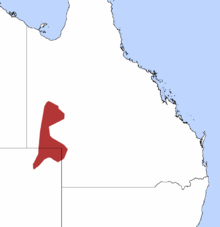Dasyuroides
| Kowari | |
|---|---|
 |
|
| Scientific classification | |
| Kingdom: | Animalia |
| Phylum: | Chordata |
| Class: | Mammalia |
| Infraclass: | Marsupialia |
| Order: | Dasyuromorphia |
| Family: | Dasyuridae |
| Subfamily: | Dasyurinae |
| Tribe: | Dasyurini |
| Genus: |
Dasyuroides Spencer, 1896 |
| Species: | D. byrnei |
| Binomial name | |
|
Dasyuroides byrnei Spencer, 1896 |
|
| Subspecies | |
 |
|
| Distribution of the kowari | |
The kowari (Dasyuroides byrnei), also known as the brush-tailed marsupial rat, Kayer rat, Byrne's crest-tailed marsupial rat, bushy-tailed marsupial rat and kawiri, is a small carnivorous marsupial native to the dry grasslands and deserts of central Australia. It is monotypical of its genus.
The kowari is 16.5–18 cm long, with a 13–14 cm tail. Its diet consists mainly of insects and spiders, but probably also small lizards, birds or rodents. It is known as a voracious predator. It lives in underground burrows, singly or in small groups. It emerges to hunt among grass tussocks for food. It breeds in winter, from May–October, and gives birth to litters of 5-6 young after a gestation of 32 days.
The kowari is coloured ashy-grey, and its distinguishing feature is the brush of black hairs on the end of its tail, which differs from that found in the mulgaras (Dasycercus) in that it completely encircles the end of the tail. They have a life span of 3–6 years.
The kowari is found in stony desert areas of the Lake Eyre drainage basin, in north-eastern South Australia and southwestern Queensland. West of Lake Eyre it is declining, and is now possibly extinct in this area.
The kowari is the only member of its genus. The genus name, Dasyuroides, indicates that it resembles Dasyurus, the quolls. First described in 1896 by Sir Walter Baldwin Spencer, it was for some time included in the genus Dasycercus.
...
Wikipedia

